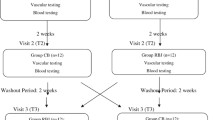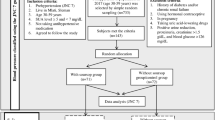Abstract
The aim of this study was to investigate the effect of chia supplementation (Salvia hispanica L.) on blood pressure (BP) and its associated cardiometabolic factors in treated and untreated hypertensive individuals. The subjects were randomly assigned to one of the following groups: the hypertensive-drug treated (CHIA-MD, n = 10), hypertensive untreated (CHIA-NM, n = 9) and placebo (PLA-MD, n = 7) groups. The subjects consumed 35 g/day of either chia flour or a placebo for 12 weeks. The clinical and ambulatory BP, inflammation, oxidative stress and markers for nitric oxide were measured. While the PLA-MD group showed no changes in BP, there was a reduction in the mean clinical blood pressure (MBP) in the CHIA (111.5 ± 1.9 to 102.7 ± 1.5 mmHg, p < 0.001) and CHIA-MD (111.3 ± 2.2 to 100.1 ± 1.8 mmHg, p < 0.001) groups. The CHIA-NM group showed no reduction in the MBP but did show a decreased systolic BP (146.8 ± 3.8 to 137.3 ± 3.1 mmHg, p < 0.05). The clinical BP reduction was demonstrated by a 24 h ambulatory systolic reduction in all of the supplemented groups. However, the mean ambulatory BP was reduced only in the CHIA (98.1 ± 2.4 to 92.8 ± 2.2 mmHg, p < 0.05) group, and there was no change in the diastolic component in either of the CHIA groups. The lipid peroxidation was reduced in the CHIA (p = 0.04) and CHIA-NM (p = 0.02) groups compared with the PLA-MD group. A reduction in the plasma nitrite levels was observed only in the CHIA group (p = 0.02). Chia flour has the ability to reduce ambulatory and clinical BP in both treated and untreated hypertensive individuals.

Similar content being viewed by others
Abbreviations
- ABPM:
-
Ambulatory blood pressure monitoring
- AGP α-1:
-
Acid glycoprotein
- BP:
-
Blood pressure
- BMI:
-
Body mass index
- CHIA-MD:
-
Chia groups previously treated with medication
- CHIA-NM:
-
Chia without medication
- DBP:
-
Diastolic blood pressure
- hs-CRP:
-
High sensitivity C-reactive protein
- MBP:
-
Mean blood pressure
- MDA:
-
Malondialdehyde
- PLA-MD:
-
Placebo with medication
- SBP:
-
Systolic blood pressure
- WC:
-
Waist circumference
References
Vieira AJ, Hinderliter AL (2009) Evaluation and management of the patient with difficult-to-control or resistant hypertension. Am Fam Physician 79:863–869, PMID: 19496385
Mohanlal V, Parsa A, Weir MR (2012) Role of dietary therapies in the prevention and treatment of hypertension. Rev Nephrol 8:413–422
Piñeiro V, Ortiz-Moreno A, Mora-Escobedo R, Hernández-Navarro MD, Ceballos-Reyes G, Chamorro-Cevallos G (2010) Effect of L-arginine oral supplementation on response to myocardial infarction in hypercholesterolemic and hypertensive Rats. Plant Foods Hum Nutr 65:31–37
Lynn A, Hamadeh H, Leung WC, Russell JM, Barker ME (2012) Effects of pomegranate juice supplementation on pulse wave velocity and blood pressure in healthy young and middle-aged men and women. Plant Foods Hum Nutr 67:309–314
Mihailovic-Stanojevic N, Belščak-Cvitanović A, Grujić-Milanović J, Ivanov M, Jovović DJ, Bugarski D, Miloradović Z (2013) Antioxidant and antihypertensive activity of extract from Thymus serpyllum L. in experimental hypertension. Plant Foods Hum Nutr 68:235–240
Tighe P, Duthie G, Voughan N, Brittenden J, Simpson WG, Duthie S, Mutch W, Wahle K, Horgan G, Thies F (2010) Effect of increased consumption of whole-grain foods on blood pressure and other cardiovascular risk markers in healthy middle-aged persons: a randomized controlled trial. Am J Clin Nutr 92:733–740
Borneo R, Aguirre A, León AE (2010) Chia (Salvia hispanica L) gel can be used as egg or oil replacer in cake formulations. J Am Diet Assoc 110:946–949
Reyes-Caudillo E, Tecante A, Valdivia-López MA (2008) Dietary fibre content and antioxidant activity of phenolic compounds present in Mexican chia (Salvia hispanica L.) seeds. Food Chem 107:656–663
Vuksan V, Jenkins AL, Dias AG, Lee AS, Jovanovski E, Rogovik AL, Hanna A (2010) Reduction in postprandial glucose excursion and prolongation of satiety: possible explanation of the long-term effects of whole grain salba (Salvia hispanica L.). Eur J Clin Nutr 64:436–438
Vuksan V, Whitham D, Sievenpiper JL, Jenkins AL, Rogovik AL, Bazinet RP, Vidgen E, Hanna A (2007) Supplementation of conventional therapy with the novel grain salba (Salvia hispanica L.) improves major and emerging cardiovascular risk factors in type 2 diabetes. Diabetes Care 30:2804–2810
Nieman DC, Cayea EJ, Austin MD, Henson DA, McAnulty SR, Jin F (2009) Chia seed does not promote weight loss or alter disease risk factors in overweight adults. Nutr Res 29:414–418
Nieman DC, Gillitti N, Jin F, Henson DA, Kennerly K, Shanely RA, Ore B, Su M, Schwartz S (2012) Chia seed supplementation and disease risk factors in overweight women: a metabolomics investigation. J Altern Complement Med 18:700–708
Brazilian Society of Cardiology, Brazilian Society of Hypertension, Brazilian Society of Nephrology (2010) VI Brazilian Guidelines on Hypertension. Arq Bras Cardiol 95:1–51. doi:10.1590/S0066-782X2010001700001
Brazilian Society of Cardiology, Brazilian Society of Hypertension, Brazilian Society of Nephrology (2011) V Brazilian Guidelines for Ambulatory Blood Pressure Monitoring and III Brazilian Guidelines for Home Blood Pressure Monitoring. Arq Bras Cardiol 97:1–24. doi:10.1590/449 S0066-782X2011001800001
Ohkawa H, Ohishi N, Yagi K (1979) Assay for lipid peroxides in animal tissues by thiobarbituric acid reaction. Anal Biochem 95:351–358
Green LC, Tannernbaum SR, Goldman P (1981) Nitrate synthesis in the germfree and conventional rat. Science 212:56–58
Otten JJ, Hellwig JP, Meyers LD (2006) Dietary Reference Intake: the essential guide to nutrient. Requeriments. The National Academies Press, Washington
Houston MC, Cooil B, Olafsson BJ, Raggi P (2007) Juice powder concentrate and systemic blood pressure, progression of coronary artery calcium and antioxidant status in hypertensive subjects: a pilot study. Evid Based Complement Alternat Med 4:455–462
Figueroa A, Sanchez-Gonzalez MA, Wong A, Arjmandi BH (2012) Watermelon extract supplementation reduces ankle blood pressure and carotid augmentation index in obese adults with prehypertension or hypertension. Am J Hypertens 25:640–643
Rodriguez-Leyva D, Weighell W, Edel AL, Lavallee R, Dibrov E, Pinneker R, Maddaford TG, Ramjiawan B, Aliani M, Guzman R, Pierce GN (2013) Potent antihypertensive action of dietary flaxseed in hypertensive patients. Hypertens 62:1081–1089
Mancia G, Fagard R, Narkiewicz K, Redon J, Zanchetti A, Bohm M et al (2013) Guidelines for the management of arterial hypertension: the task force for the management of arterial hypertension of the European Society of Hypertension (ESH) and of the European Society of Cardiology (ESC). J Hypertens 31:1281–1357
Ayerza R, Coates W (2011) Protein content, oil content and fatty acid profiles as potential criteria to determine the origin of commercially grown chia (Salvia hispanica L.). Ind Crops Prod 34:1366–1371
Poudyal H, Panchal SK, Waanders J, Ward L, Brown L (2012) Lipid redistribution by α-linolenic acid-rich chia seed inhibits stearoyl-CoA desaturase-1 and induces cardiac and hepatic protection in diet-induced obese rats. J Nutr Biochem 23:153–162
Yan Y, Jiang W, Spinetti T, Tardivel A, Castillo R, Bourquin C, Guarda G, Tian Z, Tschopp J, Zhou R (2013) Omega-3 fatty acids prevent inflammation and metabolic disorder through inhibition of NLRP3 inflammasome activation. Immunity 38:1154–1163
Giordano E, Visioli F (2014) Long-chain omega3 fatty acids: molecular bases of potential antioxidant actions. Prostaglandins Leukot Essent Fat Acids 90:1–4
Conflict of Interest
The authors declare that they have no conflicts of interest.
Author information
Authors and Affiliations
Corresponding author
Rights and permissions
About this article
Cite this article
Toscano, L.T., da Silva, C.S.O., Toscano, L.T. et al. Chia Flour Supplementation Reduces Blood Pressure in Hypertensive Subjects. Plant Foods Hum Nutr 69, 392–398 (2014). https://doi.org/10.1007/s11130-014-0452-7
Published:
Issue Date:
DOI: https://doi.org/10.1007/s11130-014-0452-7




